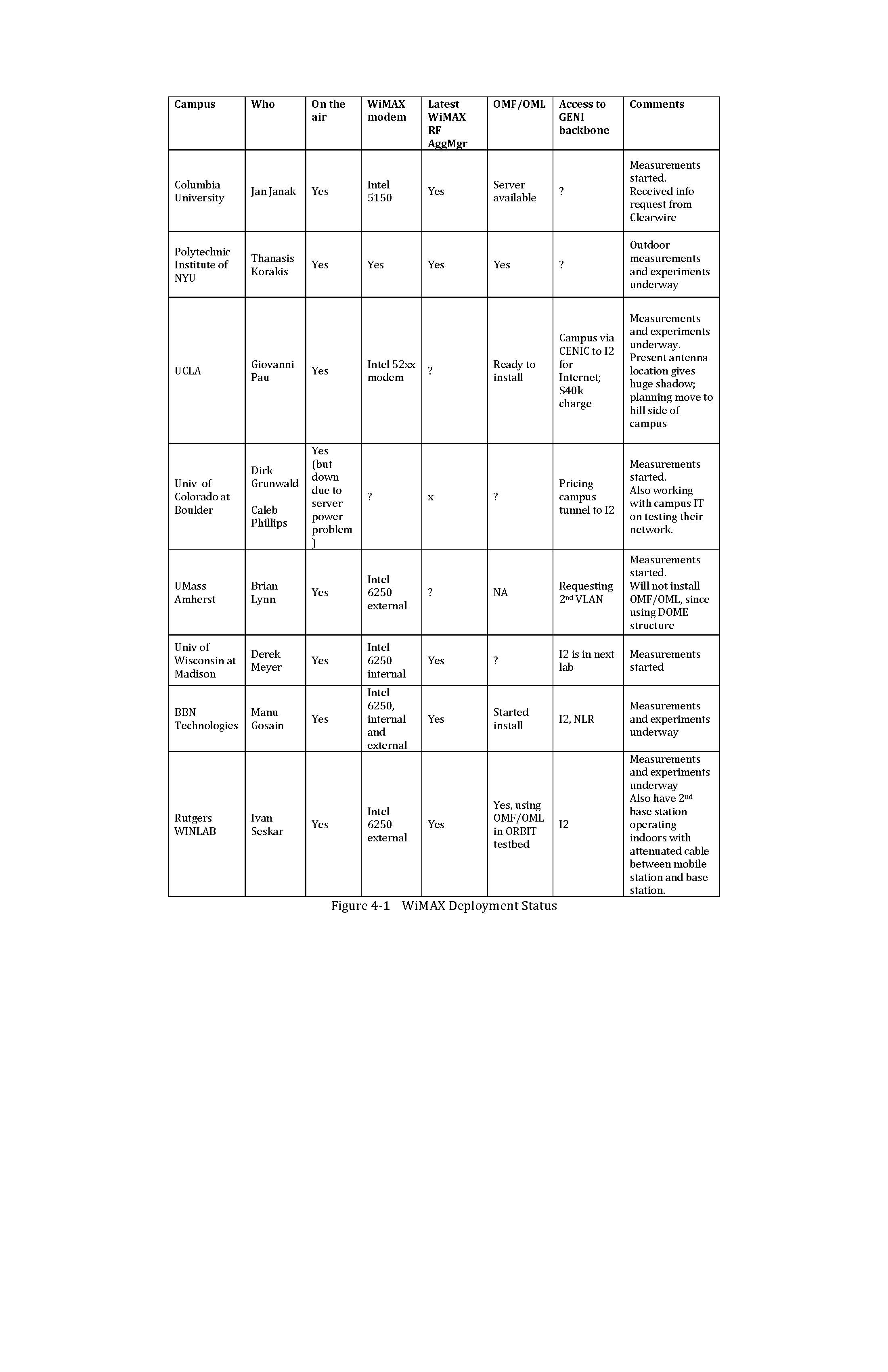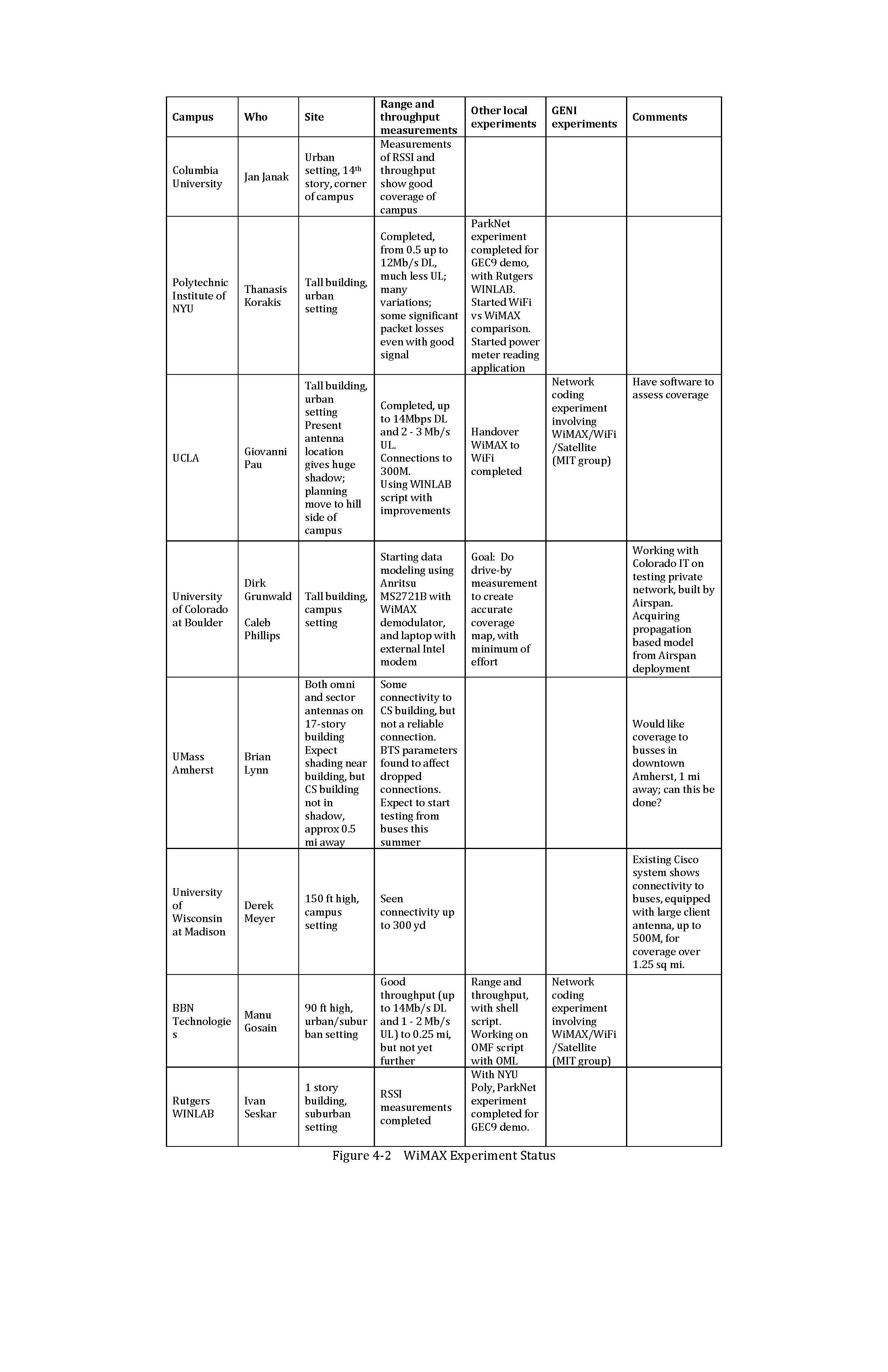WiMAX and Cluster E Deployment Calls
June 14 - June 17, 2011
Description
The projects involved in deploying WiMAX base stations reviewed their current status and progress towards their Spiral 3 roadmap goals in separate conference calls.
Attendees
BBN Technologies Harry Mussman
Columbia Univ Jan Janak (June 15)
Polytechnic Institute of NYU Thanasis Korakis (June 16)
UCLA Giovanni Pau (June 15)
Colorado Dirk Grunwald, Derek Philips (June 15)
UMass Amherst Brian Lynn (June 14)
Wisconsin Derek Meyer (June 17)
Agenda
Deployment Status
Columbia University (1770) PI: Henning Schulzrinne, Sung-Hoon Seo, Jan Janak:
After many delays, finally gained access and completed installation outdoors; see Columbia deployment. Now on the air; starting outdoor measurements.
Server available for OMF/OML.
Polytechnic Institute of NYU (1751) PI: Thanasis Korakis
slides
Installed; using WiMAX RF AggMgr, and available OMF/OML.
Completed basic range and throughput measurements; see below.
Begun work on two additional experiments; see below.
UCLA (1797) PI: Mario Gerla, Giovanni Pau
slides
slides
Antenna on 10th floor, -5deg tilt; have huge shadow; plan to move to hill side of campus.
Windows laptop with USB-connected 6250.
Measurements begun.
$40k to install link to I2.
Ready to load OMF/OML when available.
Issue: HTC EU EVO handset is not WIMAX, but is LTE. Exploring path to HTC with Mauro Sentinelli, vice-chair of GSM Forum.
Colorado: (1768) PI: Dirk Grunwald, Caleb Philips
slides
NEC BTS installed, single node on Eng Bldg; was on-the-air, but currently down, since server crashing due to power problems.
Operating in A4/B4 block; also Clearwire; also U Colorado private network, built by Airspan.
Starting data modeling using Anritsu MS2721B with WiMAX demodulator; acquiring propagation based model from Airspan deployment.
Reference: Airspan plan for U Colorado slides.
Reference: MS thesis on "Field Study of WiMAX Performance"
text.
UMass Amherst (1731) PI: Mark Corner, Brian Lynn
slides
Installed on top of 17-story building, and on-the-air.
Both omni and sector antennas, manual switch; expect shading near building, but CS building not in shadow, approx 0.5 mi away.
Connecting from ? antenna to CS building, but not reliable.
Will soon deploy on x3 DOME busses; currently antenna will be inside of the bus.
Issue: Would like coverage to downtown Amherst, 1 mi away; can this be done?
Wisconsin (1724) PI: Suman Banerjee, Derek Meyer:
slides
poster
slides
Existing Cisco system: Connectivity to buses, equipped with large client antenna, up to 500M, for coverage over 1.25 sq mi.
Have base station installed and working, with sector antenna 150 ft high, 10 deg tilt.
Using Dell mini 10, with internal Intel 6250 and internal antenna, seeing RSSI from 85 down to 50 dBm; DL up to 15 Mb/s; UL lower.
BBN Technologies Manu Gosain, Harry Mussman:
Installed and operating.
Currently adding OMF/OML.
Have completed range and throughput measurements completed; see below.
Supporting experimenters from MIT; see below.
Rutgers WINLAB Ivan Seskar:
Installed antenna on one-story building in suburban setting, and operating; using OMF/OML in ORBIT lab.
Have added a second system in lab, with coax plus attenuator connection between BS and MS.
Deployment Summary
WiMAX Range and Throughput Measurements, and Local Experiments
Columbia University (1770) PI: Henning Schulzrinne, Sung-Hoon Seo, Jan Janak:
Starting outdoor measurements; see Columbia measurements.
Measurements of RSSI and throughput show good campus coverage.
Polytechnic Institute of NYU (1751) PI: Thanasis Korakis
slides
Throughput from 0.5 to 12Mbps; asymmetry on the uplink and downlink; many variations in urban area; sometimes significant packet losses even with good signal strength.
With Rutgers WINLAB, completed ParkNet demo for GEC9.
Have begun experiment to compare WiMAX and WiFi.
Also studying power meter reading application.
UCLA (1797) PI: Mario Gerla, Giovanni Pau
slides
slides
Measurement started with dual-mode vehicular node; seeing 14Mb/s DL, 2 - 3 Mb/s UL; connect to vehicle up to 300 m; client always receives, but cannot always connect; helped by setting client IP address; windows client works better than Linux client.
Done handoff WiMAX to WiFi; heavy rain doubled delay (why?)
Using WINLAB script with improvements; will publish.
Have software to assess coverage on map: Radio Mobile for Windows.
Working with MIT group on network coding experiment over WiMAX/WiFi/Satellite.
Colorado: (1768) PI: Dirk Grunwald, Caleb Philips
Studying U Colorado private network, built by Airspan.
Reference: Airspan plan for U Colorado slides.
Starting data modeling using Anritsu MS2721B with WiMAX demodulator; acquiring propagation based model from Airspan deployment.
Goal: use drive-by measurements to create accurate coverage map with minimum effort.
Reference: MS thesis on "Field Study of WiMAX Performance"
text.
UMass Amherst (1731) PI: Mark Corner, Brian Lynn
Installed on top of 17-story building, and on-the-air.
Both omni and sector antennas, manual switch; expect shading near building, but CS building not in shadow, approx 0.5 mi away.
Connecting from ? antenna to CS building, but not reliable.
Issues with connections immediately dropped; tried different BTS parameters; found that odu-noise_floor needed to be changed from 100 (which worked at BBN) to a lower value, i.e., 40 or 4; why?
Will soon deploy on x3 DOME busses; currently antenna will be inside of the bus.
Issue: Would like coverage to downtown Amherst, 1 mi away; can this be done?
Expect to use for experiments supporting MobilityFirst project.
Wisconsin (1724) PI: Suman Banerjee, Derek Meyer:
slides
poster
slides
Existing Cisco system: Connectivity to buses, equipped with large client antenna, up to 500M, for coverage over 1.25 sq mi.
Have base station installed and working, with sector antenna 150 ft high, 10 deg tilt.
Using Dell mini 10, with internal Intel 6250 and internal antenna; script to measure RSSI and throughput; RSSI from 85 down to 50 dBm; DL up to 15 Mb/s; UL lower; better than Cisco system.
Working on video over WiMAX demo.
Want to get buses connected; need new FCC license; need more 6250s, with USB adapter; want to allow experiments on buses.
BBN Technologies, Cambridge MA Hamed Soroush, Manu Gosain, Harry Mussman:
slides
Range and throughput experiment uses shell script in mobile station and server behind base station to evaluate connection with ping and iperf.
Seeing good throughput (up to 14Mb/s DL and 1 - 2 Mb/s UL) to 0.25 mi.
Discovered antenna tilt was incorrect (too much); set to actual -2 deg; some iperf TCP and iperf UDP tests indicated longer range.
Had connectivity problem; after trial and error with BTS parameters; setting odu_noise_floor to 100 fixed the connectivity problem.
Still need to try other BTS parameter options, based on NEC suggestions.
Currently working towards use of OMF/OML to control range and throughput experiment.
Need to repeat range and throughput experiments using iperf TCP and iperf UDP.
Do not expect range beyond 0.6mi.
Supporting experimenters from MIT, who are evaluate ARQ and HARQ changes to better support video streaming.
WINLAB Ivan Seskar:
Have completed basic RSSI measurements.
With NYU Poly, completed ParkNet demo for GEC9.
GENI Experimenter Support
Experiment exchange and experimenter mailing list, at http://groups.geni.net/geni/wiki/WiMAXExper
MIT experiments, using BBN BTS: evaluate ARQ and HARQ changes to better support video streaming.
Measurements and Experiments Summary
Spiral 3 Roadmap
This roadmap shows the original and *current goals that apply to the GENI WiMAX projects:
1) Install and bring up WiMAX base station kit, including the ASN Gateway. (GEC10, or earlier) ALL COMPLETED
2) Evaluate range and thoughput of WiMAX base station kit and Linux PC with Intel WiMAX modem card and/or mobile station used for for experiments. (GEC10, or earlier) (GEC11) FIRST RESULTS NOW
3) Install and bring up an instance of OMF/OML. (GEC10, or earlier) (*GEC12) (except UMass)
4) Operate and maintain the WiMax BS and the related GENI controller, using ORBIT Management Framework (OMF), with support for remote access by GENI users. (GEC11) (*GEC12) (except UMass)
5) Present a mobility demo using WiMAX base station node, including the ASN Gateway, a Linux PC with Intel WiMAX modem card, or the dual-mode vehicular nodes, supporting both WiFi and WiMAX, required for your experiments, and a local instance of OMF/OML. (GEC10) (*GEC12)
6) Install and bring up experiment-controlled L2 (or OpenFlow) switch, to provide enhanced connectivity from the WiMAX testbed to the GENI backbone. (GEC11) (*?)
7) Install and bring up Virtual Base Station (vBS)server, to support multiple simultaneous experiments (slicing) on the GENI WiMAX base station node. (GEC11) (*?)
8) Present mobility and/or application demos/experiments, showing support for multiple simultaneous experiments (slicing) of the GENI WiMAX base station node, and remote access by GENI users, utilizing experiment-controlled L2 (or OpenFlow) switch, and Virtual Base Station (vBS) server. (GEC11) (*?)
WiMAX Developer Support
WiMAX Developer Mailing List
To post to this list, send your email to wimax-developer@winlab.rutgers.edu
PLEASE use this list for all questions, dialog, etc.
WiMAX Experimenter Support
Suggested mailing lists for WiMAX experimenters:
GENI mailing lists, including the dev, discuss and geni-announce lists, plus working groups that cover your interests.
mail to wimax-experimenter@email.orbit-lab.org for experimenters / subscribe / mailman archieve
Attachments (4)
- UCLA_Status_WiMAX_20110614.ppt (19.0 MB) - added by 13 years ago.
- 2011_06_17_Geni_Conference.pdf (226.6 KB) - added by 13 years ago.
- 071511c_Sol2_MesoScale_WiMAX_ProjectSummaries.jpg (297.4 KB) - added by 13 years ago.
- 071511d_Sol2_MesoScale_WiMAX_ProjectSummaries.jpg (454.6 KB) - added by 13 years ago.


